Children's Rights and Teachers' Roles: Early Childhood Education
VerifiedAdded on 2020/06/06
|6
|1659
|121
Essay
AI Summary
This essay delves into the critical intersection of children's rights and the pivotal role educators play in early childhood education and care. It examines the evolution of children's rights, emphasizing their recognition as competent individuals capable of making decisions, as highlighted by the UNCRC and national documents like the Melbourne Declaration. The essay explores the educator's responsibilities in safeguarding children, promoting their well-being, and fostering their development within the framework of the EYLF. It underscores the importance of understanding children's perspectives, involving them in decision-making processes, and providing them with choices to enhance their learning and understanding, aligning with Bronfenbrenner's socio-cultural theory. Furthermore, the essay discusses the ethical obligations of educators, including their duty of care, adherence to relevant government policies, and legal requirements such as the NQS, the UNCRC, and the Code of Ethics, to ensure children's safety, well-being, and overall development. The essay emphasizes the need for educators to be aware of their roles and responsibilities and to provide children with the information and support they need to navigate various situations and make informed decisions.
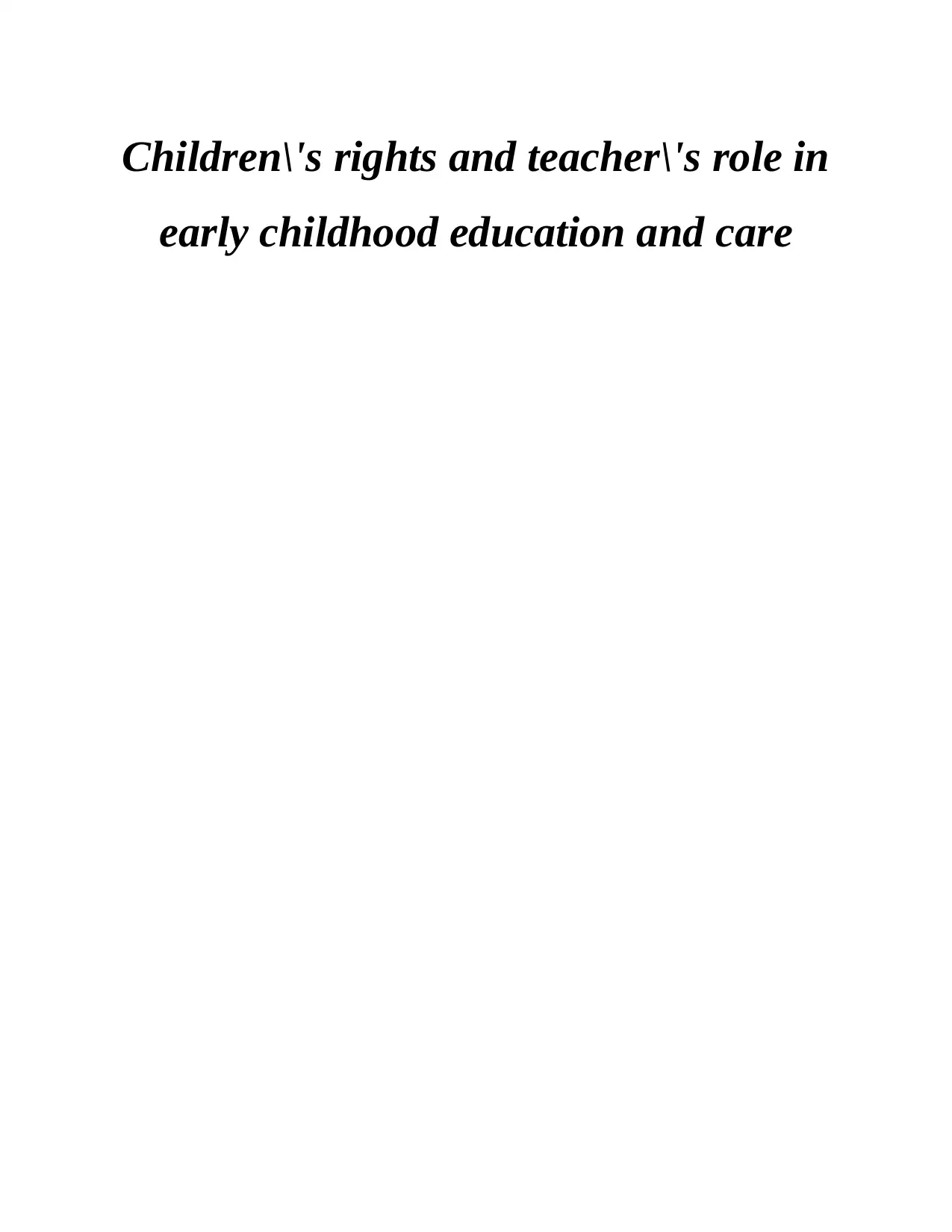
Children\'s rights and teacher\'s role in
early childhood education and care
early childhood education and care
Paraphrase This Document
Need a fresh take? Get an instant paraphrase of this document with our AI Paraphraser
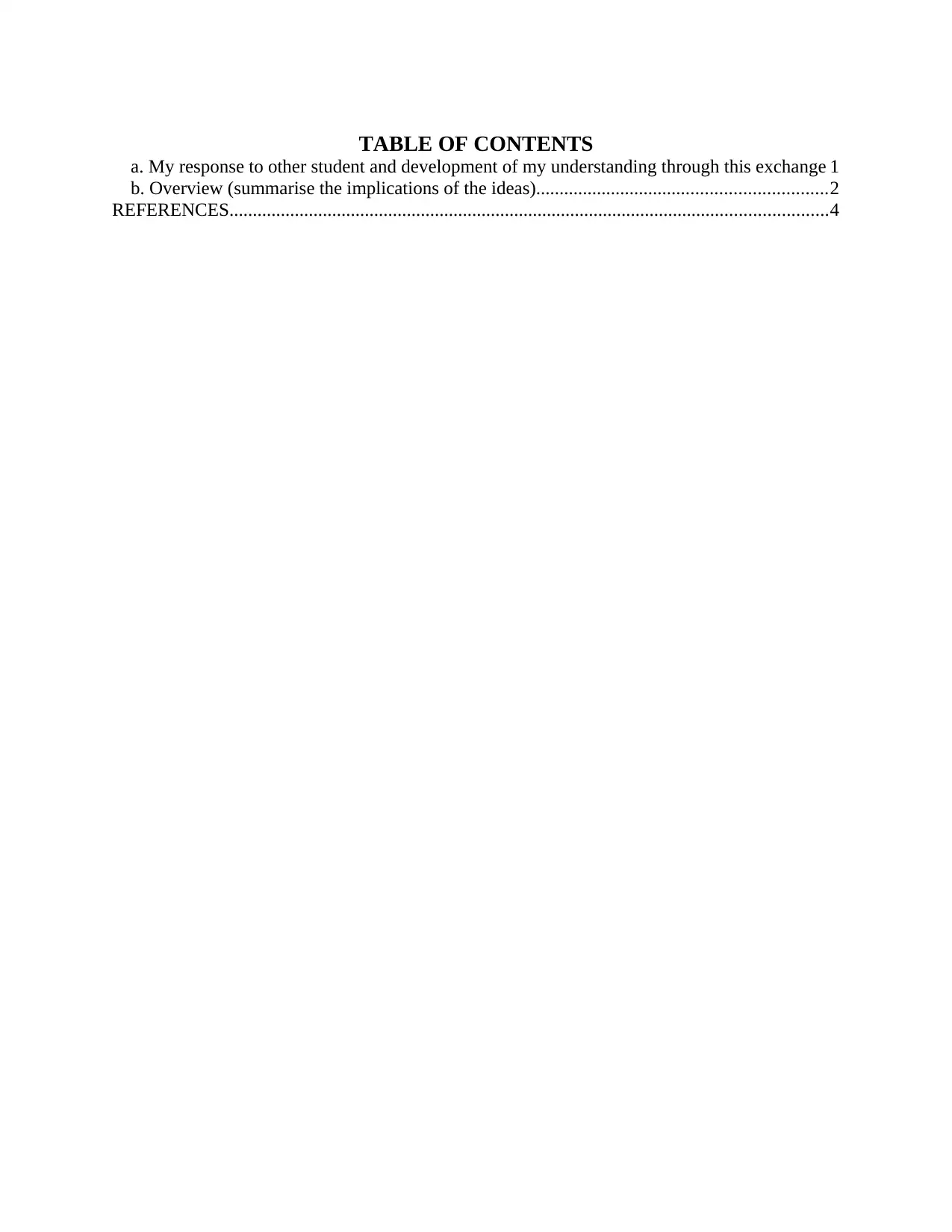
TABLE OF CONTENTS
a. My response to other student and development of my understanding through this exchange 1
b. Overview (summarise the implications of the ideas)..............................................................2
REFERENCES................................................................................................................................4
a. My response to other student and development of my understanding through this exchange 1
b. Overview (summarise the implications of the ideas)..............................................................2
REFERENCES................................................................................................................................4
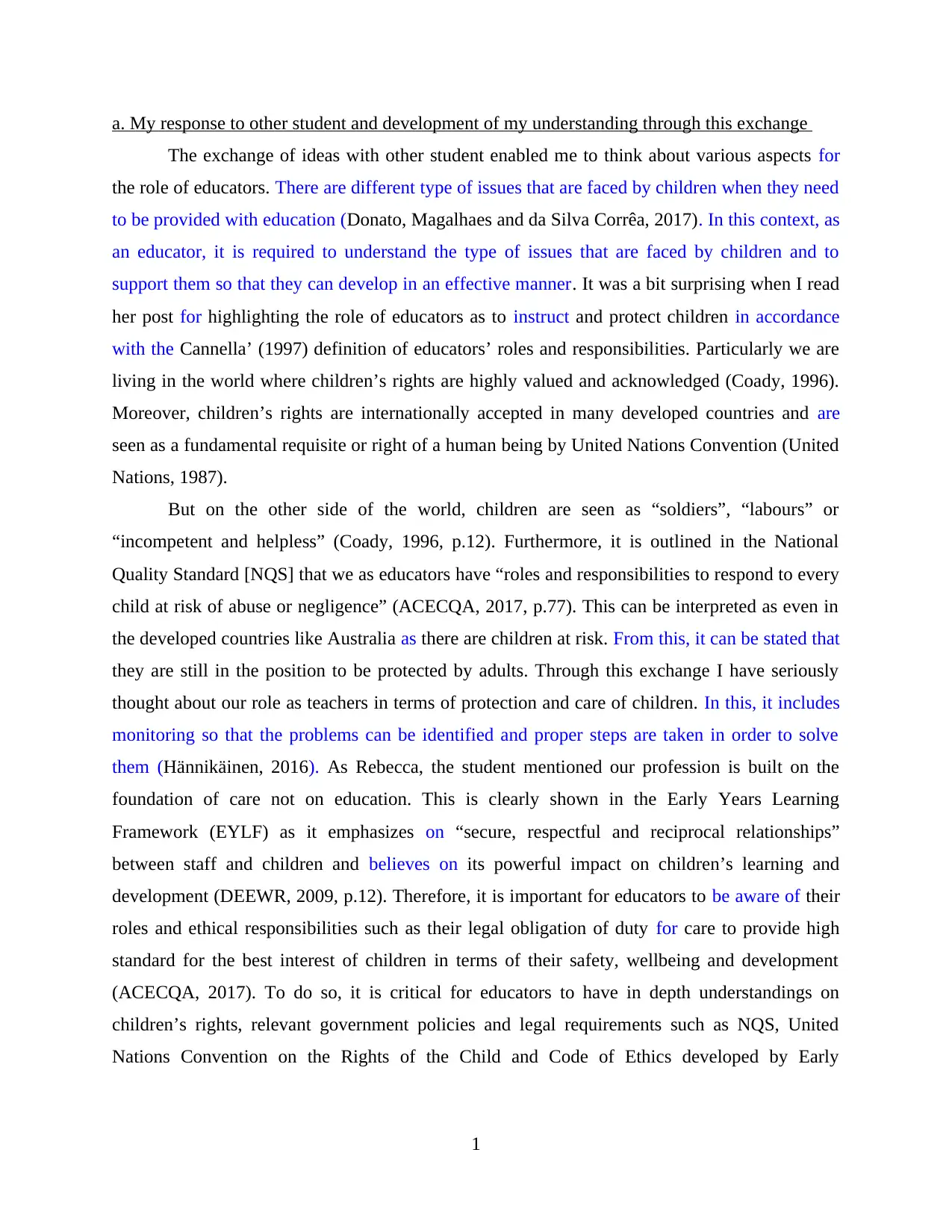
a. My response to other student and development of my understanding through this exchange
The exchange of ideas with other student enabled me to think about various aspects for
the role of educators. There are different type of issues that are faced by children when they need
to be provided with education (Donato, Magalhaes and da Silva Corrêa, 2017). In this context, as
an educator, it is required to understand the type of issues that are faced by children and to
support them so that they can develop in an effective manner. It was a bit surprising when I read
her post for highlighting the role of educators as to instruct and protect children in accordance
with the Cannella’ (1997) definition of educators’ roles and responsibilities. Particularly we are
living in the world where children’s rights are highly valued and acknowledged (Coady, 1996).
Moreover, children’s rights are internationally accepted in many developed countries and are
seen as a fundamental requisite or right of a human being by United Nations Convention (United
Nations, 1987).
But on the other side of the world, children are seen as “soldiers”, “labours” or
“incompetent and helpless” (Coady, 1996, p.12). Furthermore, it is outlined in the National
Quality Standard [NQS] that we as educators have “roles and responsibilities to respond to every
child at risk of abuse or negligence” (ACECQA, 2017, p.77). This can be interpreted as even in
the developed countries like Australia as there are children at risk. From this, it can be stated that
they are still in the position to be protected by adults. Through this exchange I have seriously
thought about our role as teachers in terms of protection and care of children. In this, it includes
monitoring so that the problems can be identified and proper steps are taken in order to solve
them (Hännikäinen, 2016). As Rebecca, the student mentioned our profession is built on the
foundation of care not on education. This is clearly shown in the Early Years Learning
Framework (EYLF) as it emphasizes on “secure, respectful and reciprocal relationships”
between staff and children and believes on its powerful impact on children’s learning and
development (DEEWR, 2009, p.12). Therefore, it is important for educators to be aware of their
roles and ethical responsibilities such as their legal obligation of duty for care to provide high
standard for the best interest of children in terms of their safety, wellbeing and development
(ACECQA, 2017). To do so, it is critical for educators to have in depth understandings on
children’s rights, relevant government policies and legal requirements such as NQS, United
Nations Convention on the Rights of the Child and Code of Ethics developed by Early
1
The exchange of ideas with other student enabled me to think about various aspects for
the role of educators. There are different type of issues that are faced by children when they need
to be provided with education (Donato, Magalhaes and da Silva Corrêa, 2017). In this context, as
an educator, it is required to understand the type of issues that are faced by children and to
support them so that they can develop in an effective manner. It was a bit surprising when I read
her post for highlighting the role of educators as to instruct and protect children in accordance
with the Cannella’ (1997) definition of educators’ roles and responsibilities. Particularly we are
living in the world where children’s rights are highly valued and acknowledged (Coady, 1996).
Moreover, children’s rights are internationally accepted in many developed countries and are
seen as a fundamental requisite or right of a human being by United Nations Convention (United
Nations, 1987).
But on the other side of the world, children are seen as “soldiers”, “labours” or
“incompetent and helpless” (Coady, 1996, p.12). Furthermore, it is outlined in the National
Quality Standard [NQS] that we as educators have “roles and responsibilities to respond to every
child at risk of abuse or negligence” (ACECQA, 2017, p.77). This can be interpreted as even in
the developed countries like Australia as there are children at risk. From this, it can be stated that
they are still in the position to be protected by adults. Through this exchange I have seriously
thought about our role as teachers in terms of protection and care of children. In this, it includes
monitoring so that the problems can be identified and proper steps are taken in order to solve
them (Hännikäinen, 2016). As Rebecca, the student mentioned our profession is built on the
foundation of care not on education. This is clearly shown in the Early Years Learning
Framework (EYLF) as it emphasizes on “secure, respectful and reciprocal relationships”
between staff and children and believes on its powerful impact on children’s learning and
development (DEEWR, 2009, p.12). Therefore, it is important for educators to be aware of their
roles and ethical responsibilities such as their legal obligation of duty for care to provide high
standard for the best interest of children in terms of their safety, wellbeing and development
(ACECQA, 2017). To do so, it is critical for educators to have in depth understandings on
children’s rights, relevant government policies and legal requirements such as NQS, United
Nations Convention on the Rights of the Child and Code of Ethics developed by Early
1
⊘ This is a preview!⊘
Do you want full access?
Subscribe today to unlock all pages.

Trusted by 1+ million students worldwide
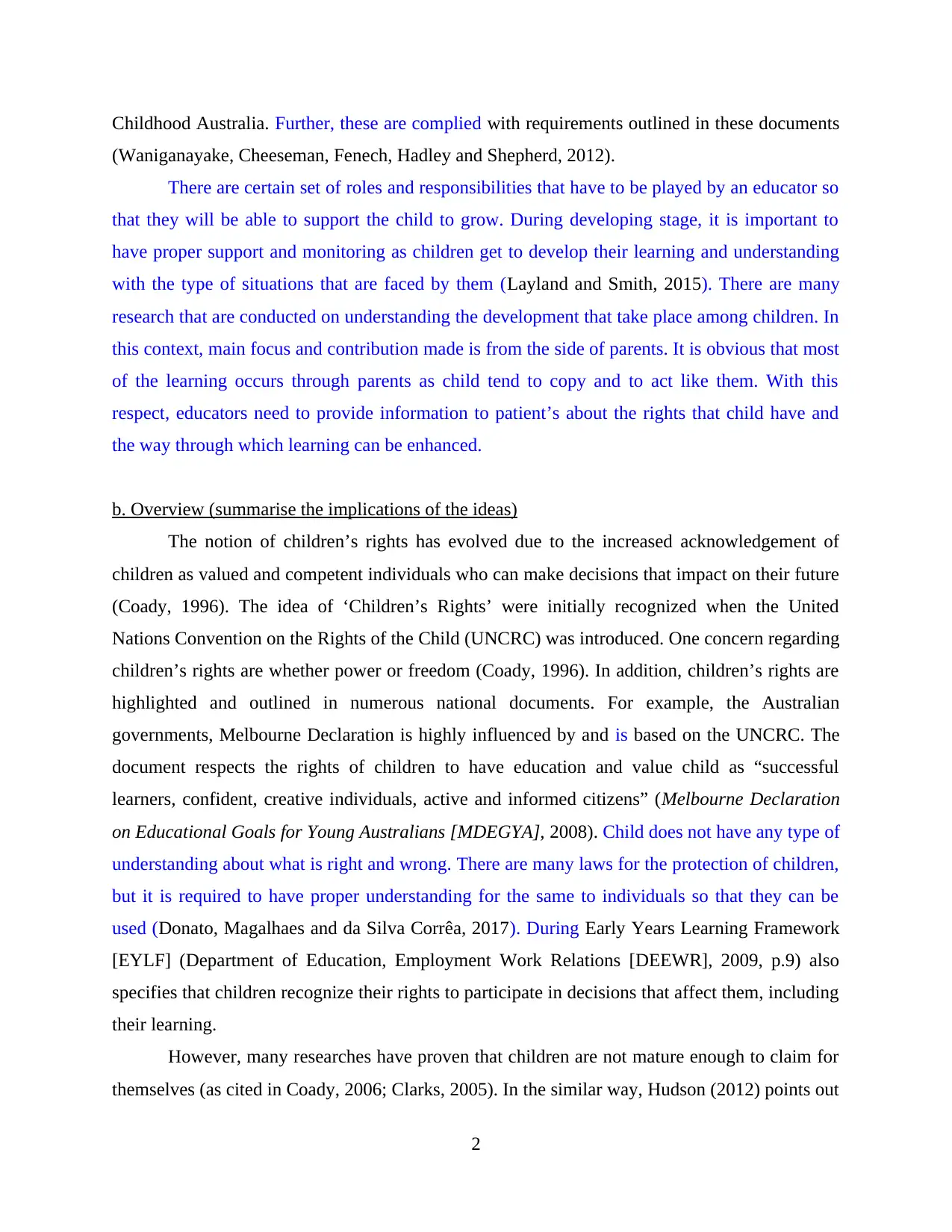
Childhood Australia. Further, these are complied with requirements outlined in these documents
(Waniganayake, Cheeseman, Fenech, Hadley and Shepherd, 2012).
There are certain set of roles and responsibilities that have to be played by an educator so
that they will be able to support the child to grow. During developing stage, it is important to
have proper support and monitoring as children get to develop their learning and understanding
with the type of situations that are faced by them (Layland and Smith, 2015). There are many
research that are conducted on understanding the development that take place among children. In
this context, main focus and contribution made is from the side of parents. It is obvious that most
of the learning occurs through parents as child tend to copy and to act like them. With this
respect, educators need to provide information to patient’s about the rights that child have and
the way through which learning can be enhanced.
b. Overview (summarise the implications of the ideas)
The notion of children’s rights has evolved due to the increased acknowledgement of
children as valued and competent individuals who can make decisions that impact on their future
(Coady, 1996). The idea of ‘Children’s Rights’ were initially recognized when the United
Nations Convention on the Rights of the Child (UNCRC) was introduced. One concern regarding
children’s rights are whether power or freedom (Coady, 1996). In addition, children’s rights are
highlighted and outlined in numerous national documents. For example, the Australian
governments, Melbourne Declaration is highly influenced by and is based on the UNCRC. The
document respects the rights of children to have education and value child as “successful
learners, confident, creative individuals, active and informed citizens” (Melbourne Declaration
on Educational Goals for Young Australians [MDEGYA], 2008). Child does not have any type of
understanding about what is right and wrong. There are many laws for the protection of children,
but it is required to have proper understanding for the same to individuals so that they can be
used (Donato, Magalhaes and da Silva Corrêa, 2017). During Early Years Learning Framework
[EYLF] (Department of Education, Employment Work Relations [DEEWR], 2009, p.9) also
specifies that children recognize their rights to participate in decisions that affect them, including
their learning.
However, many researches have proven that children are not mature enough to claim for
themselves (as cited in Coady, 2006; Clarks, 2005). In the similar way, Hudson (2012) points out
2
(Waniganayake, Cheeseman, Fenech, Hadley and Shepherd, 2012).
There are certain set of roles and responsibilities that have to be played by an educator so
that they will be able to support the child to grow. During developing stage, it is important to
have proper support and monitoring as children get to develop their learning and understanding
with the type of situations that are faced by them (Layland and Smith, 2015). There are many
research that are conducted on understanding the development that take place among children. In
this context, main focus and contribution made is from the side of parents. It is obvious that most
of the learning occurs through parents as child tend to copy and to act like them. With this
respect, educators need to provide information to patient’s about the rights that child have and
the way through which learning can be enhanced.
b. Overview (summarise the implications of the ideas)
The notion of children’s rights has evolved due to the increased acknowledgement of
children as valued and competent individuals who can make decisions that impact on their future
(Coady, 1996). The idea of ‘Children’s Rights’ were initially recognized when the United
Nations Convention on the Rights of the Child (UNCRC) was introduced. One concern regarding
children’s rights are whether power or freedom (Coady, 1996). In addition, children’s rights are
highlighted and outlined in numerous national documents. For example, the Australian
governments, Melbourne Declaration is highly influenced by and is based on the UNCRC. The
document respects the rights of children to have education and value child as “successful
learners, confident, creative individuals, active and informed citizens” (Melbourne Declaration
on Educational Goals for Young Australians [MDEGYA], 2008). Child does not have any type of
understanding about what is right and wrong. There are many laws for the protection of children,
but it is required to have proper understanding for the same to individuals so that they can be
used (Donato, Magalhaes and da Silva Corrêa, 2017). During Early Years Learning Framework
[EYLF] (Department of Education, Employment Work Relations [DEEWR], 2009, p.9) also
specifies that children recognize their rights to participate in decisions that affect them, including
their learning.
However, many researches have proven that children are not mature enough to claim for
themselves (as cited in Coady, 2006; Clarks, 2005). In the similar way, Hudson (2012) points out
2
Paraphrase This Document
Need a fresh take? Get an instant paraphrase of this document with our AI Paraphraser
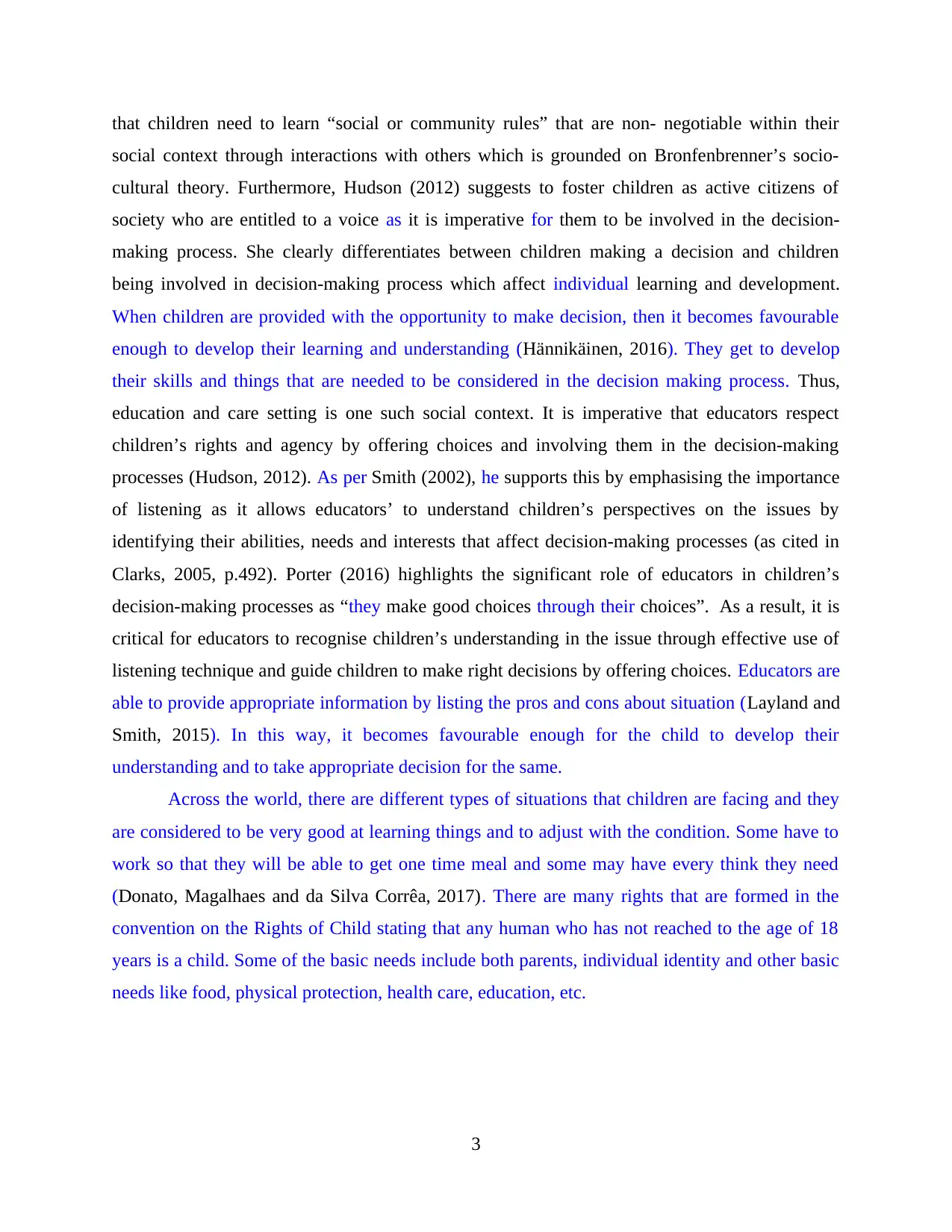
that children need to learn “social or community rules” that are non- negotiable within their
social context through interactions with others which is grounded on Bronfenbrenner’s socio-
cultural theory. Furthermore, Hudson (2012) suggests to foster children as active citizens of
society who are entitled to a voice as it is imperative for them to be involved in the decision-
making process. She clearly differentiates between children making a decision and children
being involved in decision-making process which affect individual learning and development.
When children are provided with the opportunity to make decision, then it becomes favourable
enough to develop their learning and understanding (Hännikäinen, 2016). They get to develop
their skills and things that are needed to be considered in the decision making process. Thus,
education and care setting is one such social context. It is imperative that educators respect
children’s rights and agency by offering choices and involving them in the decision-making
processes (Hudson, 2012). As per Smith (2002), he supports this by emphasising the importance
of listening as it allows educators’ to understand children’s perspectives on the issues by
identifying their abilities, needs and interests that affect decision-making processes (as cited in
Clarks, 2005, p.492). Porter (2016) highlights the significant role of educators in children’s
decision-making processes as “they make good choices through their choices”. As a result, it is
critical for educators to recognise children’s understanding in the issue through effective use of
listening technique and guide children to make right decisions by offering choices. Educators are
able to provide appropriate information by listing the pros and cons about situation (Layland and
Smith, 2015). In this way, it becomes favourable enough for the child to develop their
understanding and to take appropriate decision for the same.
Across the world, there are different types of situations that children are facing and they
are considered to be very good at learning things and to adjust with the condition. Some have to
work so that they will be able to get one time meal and some may have every think they need
(Donato, Magalhaes and da Silva Corrêa, 2017). There are many rights that are formed in the
convention on the Rights of Child stating that any human who has not reached to the age of 18
years is a child. Some of the basic needs include both parents, individual identity and other basic
needs like food, physical protection, health care, education, etc.
3
social context through interactions with others which is grounded on Bronfenbrenner’s socio-
cultural theory. Furthermore, Hudson (2012) suggests to foster children as active citizens of
society who are entitled to a voice as it is imperative for them to be involved in the decision-
making process. She clearly differentiates between children making a decision and children
being involved in decision-making process which affect individual learning and development.
When children are provided with the opportunity to make decision, then it becomes favourable
enough to develop their learning and understanding (Hännikäinen, 2016). They get to develop
their skills and things that are needed to be considered in the decision making process. Thus,
education and care setting is one such social context. It is imperative that educators respect
children’s rights and agency by offering choices and involving them in the decision-making
processes (Hudson, 2012). As per Smith (2002), he supports this by emphasising the importance
of listening as it allows educators’ to understand children’s perspectives on the issues by
identifying their abilities, needs and interests that affect decision-making processes (as cited in
Clarks, 2005, p.492). Porter (2016) highlights the significant role of educators in children’s
decision-making processes as “they make good choices through their choices”. As a result, it is
critical for educators to recognise children’s understanding in the issue through effective use of
listening technique and guide children to make right decisions by offering choices. Educators are
able to provide appropriate information by listing the pros and cons about situation (Layland and
Smith, 2015). In this way, it becomes favourable enough for the child to develop their
understanding and to take appropriate decision for the same.
Across the world, there are different types of situations that children are facing and they
are considered to be very good at learning things and to adjust with the condition. Some have to
work so that they will be able to get one time meal and some may have every think they need
(Donato, Magalhaes and da Silva Corrêa, 2017). There are many rights that are formed in the
convention on the Rights of Child stating that any human who has not reached to the age of 18
years is a child. Some of the basic needs include both parents, individual identity and other basic
needs like food, physical protection, health care, education, etc.
3
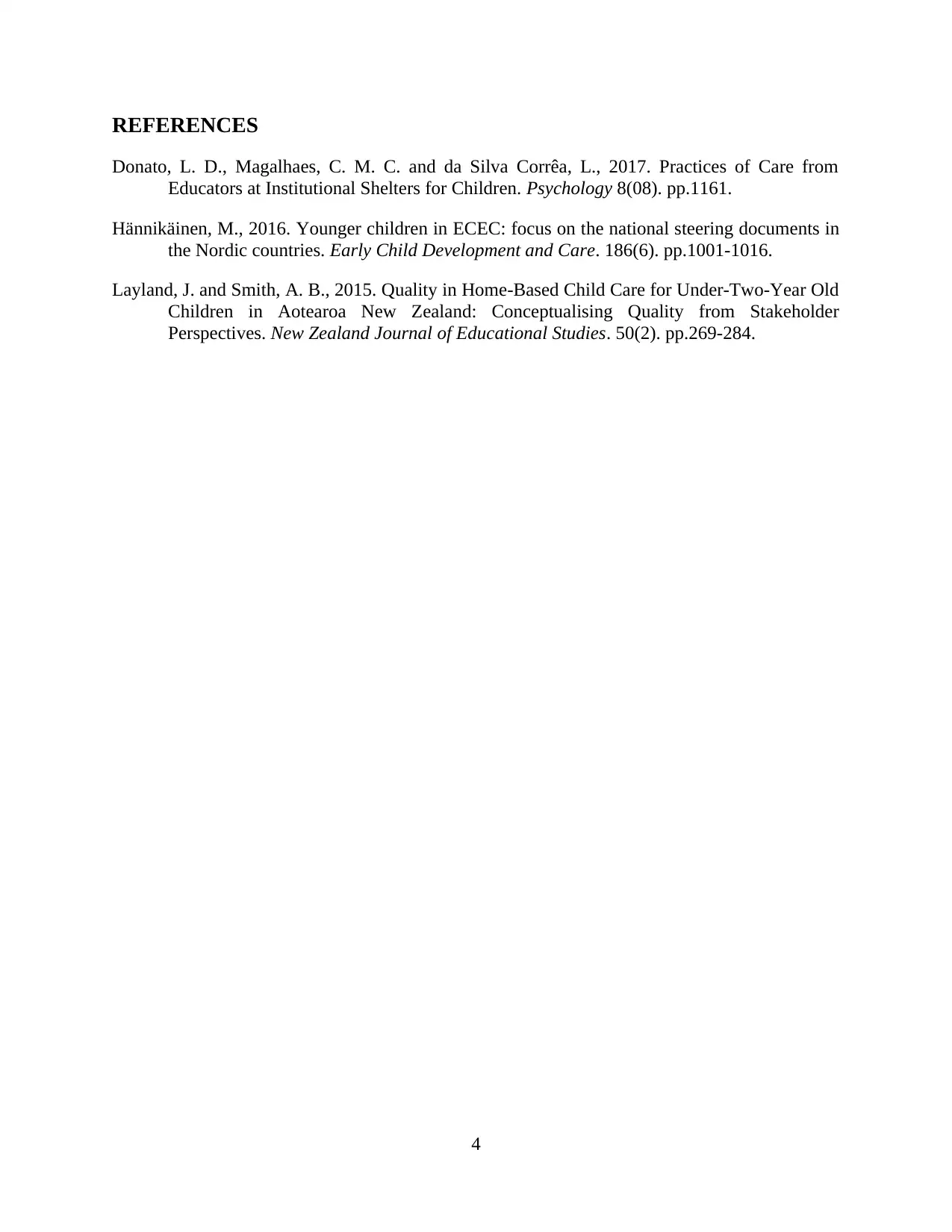
REFERENCES
Donato, L. D., Magalhaes, C. M. C. and da Silva Corrêa, L., 2017. Practices of Care from
Educators at Institutional Shelters for Children. Psychology 8(08). pp.1161.
Hännikäinen, M., 2016. Younger children in ECEC: focus on the national steering documents in
the Nordic countries. Early Child Development and Care. 186(6). pp.1001-1016.
Layland, J. and Smith, A. B., 2015. Quality in Home-Based Child Care for Under-Two-Year Old
Children in Aotearoa New Zealand: Conceptualising Quality from Stakeholder
Perspectives. New Zealand Journal of Educational Studies. 50(2). pp.269-284.
4
Donato, L. D., Magalhaes, C. M. C. and da Silva Corrêa, L., 2017. Practices of Care from
Educators at Institutional Shelters for Children. Psychology 8(08). pp.1161.
Hännikäinen, M., 2016. Younger children in ECEC: focus on the national steering documents in
the Nordic countries. Early Child Development and Care. 186(6). pp.1001-1016.
Layland, J. and Smith, A. B., 2015. Quality in Home-Based Child Care for Under-Two-Year Old
Children in Aotearoa New Zealand: Conceptualising Quality from Stakeholder
Perspectives. New Zealand Journal of Educational Studies. 50(2). pp.269-284.
4
⊘ This is a preview!⊘
Do you want full access?
Subscribe today to unlock all pages.

Trusted by 1+ million students worldwide
1 out of 6
Related Documents
Your All-in-One AI-Powered Toolkit for Academic Success.
+13062052269
info@desklib.com
Available 24*7 on WhatsApp / Email
![[object Object]](/_next/static/media/star-bottom.7253800d.svg)
Unlock your academic potential
Copyright © 2020–2025 A2Z Services. All Rights Reserved. Developed and managed by ZUCOL.



